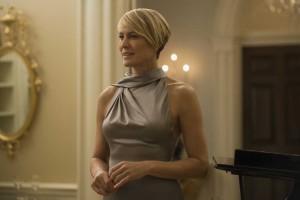![]()
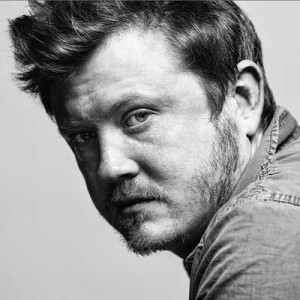
In preparing for a new season, before they begin breaking each episode one-by-one, the writers have a six-week period where they “break the grid” – essentially mapping out the 13 episodes in broad strokes, including any character and story threads that will be explored. At the end of that process, the show has a season “Bible” – a 60-70 page document that outlines all the major arcs and themes, and gives a basic idea of what will happen in each episode.
In total 800 script pages are written each season – the equivalent of seven feature films – with a seven-month schedule to shoot. Generally two episodes are shot at a time, giving the company a bit more flexibility in terms of organizing location and stage days. Willimon said that it is important to share and discuss as much of this information with the department heads as early as possible, because “The more they know, the better they can do their job.”
The cinematic look and camera-style for the series – set during the pilot by executive producer and director David Fincher and season one cinematographer Eigil Bryld – has been continued through the subsequent seasons with Igor Martinovic in season two and Martin Ahlgren and Peter Konczal in season three. To get a handle on the rather classic and austere feel, the team watches the work that was done before and discusses their ideas with the showrunner and executive producers.
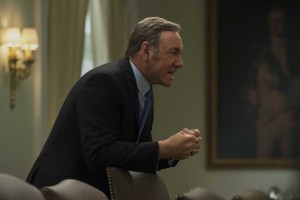
Jay has creative input about how a scene can best be filmed. He works in close concert with the cinematographer and gaffer, Robert Driskell. The style of the show depends upon the framing, the type of lens and what the camera sees. It is important for the cast to feel that the person pointing the camera at them understands their performance and the show. Jay’s relationship with the actors imparts a huge degree of confidence.
The camera department follows general rules that lead to a cinematic approach to the show according to Willimon. “Most notably, we don’t use handheld, just Steadi-Cam. Everything is on a dolly, a track or a crane. We tend to avoid long lenses. We have a very strict color palette. Typically we like movement of the camera to be motivated – the action motivates the movement of the camera, as opposed to it just moving on its own for no reason.”
“All of that said, we break those rules from time to time,” Willimon added. This deviation can come from the cinematographer, the director or the two of them working in concert. “We have those parameters so that when we do move outside them, we’re doing so very deliberately, for good reason.”
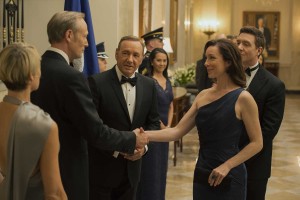 An example of this rule breaking occurred in season three’s final episode during a violent scene between Francis (Kevin Spacey) and Claire (Robin Wright). Both director James Foley and Ahlgren felt it was important to get tight in on the action with the actors, so in that instance handheld was used.
An example of this rule breaking occurred in season three’s final episode during a violent scene between Francis (Kevin Spacey) and Claire (Robin Wright). Both director James Foley and Ahlgren felt it was important to get tight in on the action with the actors, so in that instance handheld was used.
“This way of working forces all involved to be very clear about what they are doing. The idea is to take time to compose scenes, rather than to just whip them off,” explained Willimon.
The production has about 200,000 sq. feet of stages in Maryland. Production designer Steve Arnold, art director Halina Gebarowicz and set decorator Tiffany Zappulla have been on the show since the beginning and not only work on set, but on location as well. The company spends a bit more than half its time on the stages and the remainder on location. Don Burt, production designer for the first two shows, built sets for season one, but those have been expanded upon or changed.
The White House residence in season three is all the work of Arnold, Gebarowicz and Zapulla. The elements of those sets were not available as pre-fab parts. They are unique, so everything was custom and had to be designed and built in house.
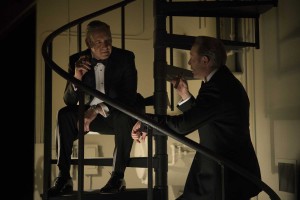 “They did an incredible job researching that, building it so that it was flexible in terms of what we could do on film,” shared Willimon. “We’re trying to create the grandiosity of serving in Washington, whether that be in Congress on in the White House.”
“They did an incredible job researching that, building it so that it was flexible in terms of what we could do on film,” shared Willimon. “We’re trying to create the grandiosity of serving in Washington, whether that be in Congress on in the White House.”
The level that goes into creating the world gives the actors and directors more options and extends to the prop department, headed by property master Kristina Kilpe. The story takes place in a very specific world so there is a need for very precise props from the table dressings at a state dinner, to a particular assault weapon that the military might use, to the stationary on the President’s desk. The research done on the props is a big part of creating a real place.
“It goes all the way down to what you might find in the drawers,” revealed Willimon. “If you are on any of our sets and you open a drawer, say in a Congressional office, you will find the things that you would normally find in that drawer, even if you never see them on camera. They understand that creating the world isn’t just for what appears on screen, but also for the environment that the actors are stepping into. To know that every detail has been thought of, helps them in creating the suspension of disbelief for us all.”
One of the most incredible feats of design on the series was creating the United Nations Security Council in season 3. The company initially probed the U.N. about shooting at the actual location, but that idea proved to be both impractical and tough politically. Arnold built the chamber in a big warehouse. The walls were green-screened. The set completed by the VFX team was about “as close to the Security Council as you can get.” Willimon credits post supervisor Hameed Shaukat with overseeing the green scenes, set extensions and other visual effects needed for the show.
Some sets, such as the attic room that Lisa (Kate Lyn Sheil) lives in, were not based upon any real locations. These sets were opportunities to tell story, using space. “Things are wide open when it comes to that. We can do anything we want,” explained Willimon. “I had discussions with Steve and Tiffany about what we can say about those characters. They often come up with elements that we haven’t scripted that help us to add more layers to the character. That collaboration is fantastic.”
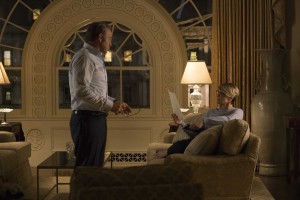 Casting is one of Willimon’s favorite parts of the process. He credits much of the success of the series to the ability of casting directors Laray Mayfield and Julie Schubert to tap actors that are right for each role. The duo is as engaged in casting an unnamed staffer as they are in casting a big reoccurring role. Because the company is trying to create a world on every level, they understand that one “weak link” can make it tough for the regulars to do their job. Because of the casting directors’ vast knowledge of the talent pool and their instincts with emerging artists, many first time actors have had an opportunity on the series.
Casting is one of Willimon’s favorite parts of the process. He credits much of the success of the series to the ability of casting directors Laray Mayfield and Julie Schubert to tap actors that are right for each role. The duo is as engaged in casting an unnamed staffer as they are in casting a big reoccurring role. Because the company is trying to create a world on every level, they understand that one “weak link” can make it tough for the regulars to do their job. Because of the casting directors’ vast knowledge of the talent pool and their instincts with emerging artists, many first time actors have had an opportunity on the series.
“They are amongst the very best in the business. They bring so much to the show,” said Willimon. “A show is not worth doing if you don’t have a great cast. We all show up, point a camera in a room, and light it, and wire it for sound, and all that stuff so that we can catch lighting in a bottle. We can capture actors doing surprising things.”
Even before a script is broken in the writers’ room, Willimon starts talking with Mayfield and Schubert about roles that are up-coming. An actor being considered can sometimes influence the scripts or a role can be tailored more specifically for that actor’s strengths. There is a constant back-and-forth conversation that includes the directors. Many things are taken into consideration in casting, such as, what the show is trying to accomplish and a particular actor’s dynamics with the established actors.
“I always learn something from them,” said Willimon. “They are as astute at uncovering the possible layers of the character as where they might be going in relation to the page.”
Costume designer Johanna Argan has a titanic task each season not only providing the sheer volume of wardrobe, but also evolving the look of series regulars, as well as handling extras that run the gamut from blue collar folks, to rich donors, to military, to Capital Hill staffers – a broad world that requires the costume designer to become an expert in a lot of different milieus. Aspects of the costume design are not always as flashy as Francis’ suits or Claire’s dresses, but are important to complete the picture.
“To costume our actors so beautifully is a real dance. She is light on her feet and graceful, and also pays particular attention to character,” stated Willimon. “One of the things that establishes a character the most visually is what they wear. We often talk not just about what a person will look good in, but what it says about who they are, the story that we’re trying to tell. And people pay attention, a lot of attention, to the fashion on our show. ”
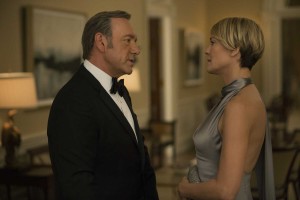 The costume designer – as well as the art department – work within the limited color palette established by Fincher in season one. The director wanted a dramatic look to the show, and at times a more noir-ish look, so bright colors are not used. The preferred palette lives in black and white and grey, tan and brown and muted colors.
The costume designer – as well as the art department – work within the limited color palette established by Fincher in season one. The director wanted a dramatic look to the show, and at times a more noir-ish look, so bright colors are not used. The preferred palette lives in black and white and grey, tan and brown and muted colors.
Byron Smith and Lisa Bromwell edited season three. The style of the editing needed to dovetail with the esthetic established in the pilot. Instead of flipping back and forth, focusing on the speakers delivering their lines, as is common in TV editing, the frame often captures the reaction. “We try to make choices as to what is the most dramatic thing we want to see in a moment,” said Willimon.
The directors have two or three cuts on an episode before Willimon comes in, but they also put a lot of thought into the editing before the footage gets to the editors. Using only dollies, tracks and cranes, makes it a necessity for them to compose scenes in their minds before it gets to post. Nevertheless, multiple setups and angles provide numerous options in the cutting room. Although they generally stick to the script, there is room to experiment with scene order or removing lines in order to see how those changes affect the rhythm and pace of an episode. It is about getting into the nuance.
“Sometimes those choices are better than what was originally scripted. Other times we decide to stick with what’s closer to the script,” said Willimon who likes to see what his team can come up with. “They each have their own voice, but they are also very cognizant of the core look of the show. And they also have great instinct for story. Writing doesn’t finish until editing.”
Willimon does not want to micromanage. He feels that most of his work should be done on the page and in filming. “If we’ve done our work right, then it gives the director and editor a lot to work with.” He does not sit in the edit room, but rather gives notes on the edit so that editorial has “as much freedom as possible.”
Sound mixing, sound recording and music are intrinsic elements for the show. Fincher is known to be meticulous on all fronts and that includes his approach to sound. According to Willimon, the director raised a high bar, which the sound team maintains with pride. Their goal is a clear, layered sound because without the voices “you don’t get the performance.” Everything comes together in the mixing with really subtle work that allows the focus in a scene to be shifted sonically. The mix also completes the world with ambient sound.
Jeff Beal composes all of the music. He starts with sketches before there is a script so that the company can start to hear what will be the “sonic landscape” for the season. The team will talk, adjust and change. As rough cuts come in, the composer works with the actual scenes to finesse the score to picture. Working on the show from the beginning, Beal did not just create the music for season one and then recycle it in subsequent seasons. New compositions respond to the evolution of the story.
“The voice of the show could not exist without the soundtracks that he gives us,” explained Willimon. “I’ll talk to Jeff not only about what is going on in the story, but about some of the feelings and themes that we want to explore. What is so exciting to me is that the music will evolve. There might be certain motifs or melodies, or themes that you will hear variations of, but you are also hearing new stuff each season.”
Beal does not score every second of the show. Often he sits back and lets the scene unfurl on its own. Music is not just used to amplify the intent of a scene either, but rather Beal picks and chooses the moments that add new layers.
“Jeff has a great talent for restraint,” remarked Willimon. “There may be music in a scene that feels in contradiction to what’s happening emotionally, until you realize what he is doing. The music is giving us access to notes in the actor’s performance that might be beneath the surface. He takes a really sophisticated approach to music.”
“If it were up to me, I would love to talk about all of the many dozens of people working on the series,” said Willimon. We can’t make the show without any of them. We’ve got a well-oiled machine here. Everyone takes great pride in their work. It is my honor to work with all of them.”
Editor’s Note: House of Cards has been nominated for Emmy awards for outstanding production design for a narrative contemporary or fantasy program (one hour or more), outstanding casting for a drama series, outstanding cinematography for a single-camera series, outstanding music composition for a series (original dramatic score), outstanding lead actor in a drama series, outstanding lead actress in a drama series, outstanding supporting actor in a drama series, outstanding guest actor in a drama series, outstanding guest actress in a drama series, outstanding drama series, and outstanding sound mixing for a comedy or drama series (one hour).

